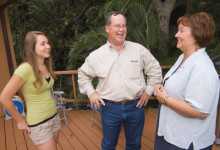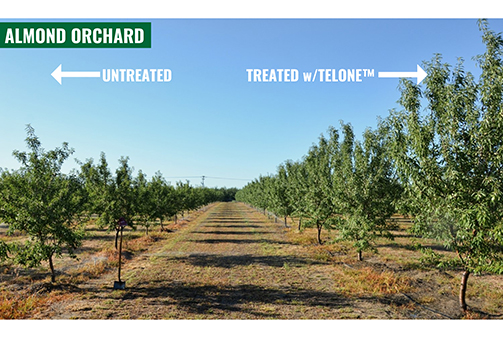Room For Growth In The Citrus Industry

Mule sleds carrying 55-gallon drums of pond water were cutting-edge technology for a citrus grove irrigation system in 1875. And while that would be any modern day grower’s nightmare, it’s how Tom Whaley began his farming operation in Central Florida, following the “War of Northern Aggression.”
The former Confederate soldier, who did not sign an oath of loyalty to the Union, made his way to Florida in the years following General Robert E. Lee’s surrender at Appomattox. With his pension from the service, Whaley sought a living from the state’s rich agricultural industry, specifically cattle and citrus.
His 1,200-acre homestead, which bears no official name, lies southeast of Kissimmee and is now just a five-minute drive from Florida’s Turnpike. It still stands at 127 years old, along with the foundation of an old paddlewheel house that resides on a portion of the property’s 2½-mile shoreline on Lake Tohopekaliga.
Florida ranching was difficult in those days, when the state was barely 30 years old. Everything was done by hand.
The Whaley ranch’s largest expansion occurred a generation later, near the turn of the century when Alexander Whaley, the eldest son, began buying massive parcels from Kissimmee to the south. “My great grandfather expanded the ranch quite a bit,” says Shane Platt, the family’s fifth generation to run the Osceola operation. “In fact at one time, we would have had, what is our current ranch, all the way south down to Kenansville.
“He was really one of the first cattlemen to really expand and buy land,” Platt continues. “He died at a young age though.”
But it was Cecil Whaley, Platt’s grandfather, who kept the ranch together, oversaw its operations, and turned it into a profitable business. At 97 years old, he’s still tending the fields, although not as much as he once did.
Two years ago Cecil Whaley stopped fertilizing and irrigating the groves on his own. He thought it best to take a rest, Platt says.
“He kept that ranch together,” he continues. “Not all of the ranch; they had to sell quite a bit of it and trade back and forth. But he kept enough for basically seven family members to all have a piece and all have a ranch. “They ran them all as one block for years, but split them apart as they got older.”
With development encroaching on their land, the family has diversified its holdings and now operates ranches in both Hardee and Polk counties. But with new technologies and techniques, managing them isn’t nearly as difficult as it once was.
Times They Do Change
Tending to the fields by hand has become a much more technological process. The days of the mule wagon and water drums are a thing of the past.
But those advances allowed growers to expand their operations and land holdings, and put the state at the top of the charts for world orange juice production. “Now we have low volume jet irrigation that can water the whole grove at one time instead of taking a bucket to a tree,” Shane Platt says. “One of the reasons people expanded their grove operation was because the water situation improved. All the things have changed or are getting better.”
But while there have been many improvements to increase a grove’s production and fruit yield, there are new obstacles facing today’s growers. During the 2004 and 2005 hurricane seasons, storms took their toll on the groves. The storms, some of the worst in the state’s history, spread citrus canker through all parts of the state. Citrus greening was then discovered in August 2005. And in March, USDA decreased its 2006-07 season estimate by 8 million boxes, dropping it to 132 million boxes, the lowest production since the industry’s worst freeze during the 1989-90 season that produced 110.2 million boxes.
Keeping with the citrus industry is becoming more and more difficult for growers. Many are searching for and developing new ways to fight against the state’s declining citrus yields.
“I’m a firm believer that we are going to have to look at precision agriculture in the future,” Platt says. “That means spray now and fertilize only the trees or even judge how much tree is there and throw the proper amount of fertilizer or spray onto the tree. It’s the only way we are going to survive with as many trees going out with tristeza and as many diseases are coming up.”
Platt adds, “When I planted my first grove I did the first fertigation unit on the grove. That’s where you inject the fertilizer through the irrigation system. It helped me to do more with less time than ever before.”
A Fight To The Finish
Many growers who lost their groves to diseases have sold family land holdings to developers instead of replanting, while others couldn’t resist the temptation of high land values. It’s partly the cause for Florida’s recent population boom. As new tracts of land opened up for large national developers and more rooftops, large portions of Florida’s landscape have been transformed. Citrus is out, and in the tourism-rich Kissimmee and St. Cloud regions, the dollars are in development.
But that development is now infringing on a generations-old tradition — the passing of land holdings from one generation to the next. And in the case of Shane and Carol Platt, there might not be much left to pass down to their children, Joshua and Jenna. “One of the things that we always try to stress, and that’s in everything we have ever done in agriculture, is that a viable agricultural industry is the best growth management tool the state can have,” says Carol Platt. “And not only that, but it’s constitutional.”
The couple’s biggest obstacle right now is the rise in land cost caused by six DRI (development of regional impact) projects that surround the 1,200-acre property. While the Platt’s land holdings are still considered agricultural, its values have still increased dramatically because of the developments. And when it comes time to bequeath their holdings to the sixth generation, estate taxes will wipe out nearly half of the land. To afford to keep some of the property, the Platt children will need to sell off portions to pay the tax.
“We’ve kept it green,” says Shane Platt. “We’ve got citrus on it. We’ve got cattle on it. We have all the wildlife we need on that property. But we’ve done that over 125 years. It’s not that we just walked in and bought it a year ago. It’s been there and we are trying to keep it.”
The scenario is becoming an increasing problem for older generations of land owners throughout the agricultural industry. “We are pretty big on property rights,” he says. “I think just about everybody in agriculture is because we get assaulted by everybody.”
To stay in the business, Florida growers are being forced to become more creative in how they operate. The Platts have their own teams of lawyers, accountants and, yes, even a lobbyist. “People still don’t want that kind of development next to them. But growth is here,” Shane Platt says. He wants to be able to pass on the tradition to the next generation. His ancestral ties are strong here, as are the memories cultivated with his wife and children.
On a map, Platt can point out where he shot his first turkey and where Jenna, his daughter, took her first deer. It has all happened on the property that has been maintained by their family for more than a century. And this land is part of a cultural heritage that is quickly fading across the state.
“You ought to see the size of the oaks on some of this,” Platt says. “It’s definitely old Florida.”









